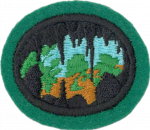Difference between revisions of "AY Honors/Caving/Answer Key/es"
(Created page with "</noinclude> <!-- 2. Hacer una lista de todos los equipos necesarios para el éxito de una salida de espeleología excluyendo los equipos de descenso vertical y comenzar a ela...") |
(Created page with "</noinclude> <!-- 3. Localizar un espeleólogo experimentado y unirse a esa persona en la exploración de por lo menos tres cuevas relativamente fáciles. -->") |
||
| Line 40: | Line 40: | ||
{{ansreq|page={{#titleparts:{{PAGENAME}}|2|1}}|num=3}} | {{ansreq|page={{#titleparts:{{PAGENAME}}|2|1}}|num=3}} | ||
<noinclude></noinclude> | <noinclude></noinclude> | ||
| − | <!-- 3. | + | <!-- 3. Localizar un espeleólogo experimentado y unirse a esa persona en la exploración de por lo menos tres cuevas relativamente fáciles. --> |
{{clear}} | {{clear}} | ||
Revision as of 08:54, 20 January 2021
| Espeleología | ||
|---|---|---|
| Asociación General
|
Destreza: 2 Año de introducción: 1973 |
|
Requisitos
|
La especialidad de Espeleología es un componente de la Maestría Recreación. |
1
Es extremadamente importante tener al menos tres fuentes de luz en caso de que falle una luz. Su luz primaria y secundaria deben poder montarse en la cabeza, pero es mejor si las tres fuentes de luz se pueden montar en la cabeza.
2
3
4
It is best to write down information about your trip as soon after the trip as you can. Otherwise, you might forget some of the details. Compare notes with others who went on the trip. If everyone agrees with your data, it is likely to be more accurate.
5
Never cave alone. A group of 3 or 4 is small enough to move quickly, yet big enough to allow flexibility in emergencies. If someone is injured, at least one person should stay with them while others go for help.
Make sure someone knows where you are going and when you are expected to return. Allow some leeway on return times since trips often take longer than expected, but having someone ready to call for help if your group is overdue is a wise precaution.
Move carefully in the cave. Uneven ground, low ceilings and pits make running and jumping dangerous. Climbs, crawls and rough terrain can make even a sprain a big problem for getting out of the cave.
Be aware of the nature of the caves you are visiting. For example, caves with streams may be prone to flooding and a sharp eye may need to be kept on the weather. Other caves require climbing skills or vertical equipment that you or others in your party may not have.
If you run out of light or become hopelessly lost get into a safe position and wait for help (you did tell someone where you were going didn't you?).
Solo tome fotos, solo deje huellas, no mates nada mas que el tiempo (esto incluye no tocar o romper las formaciones de piedra en la cueva que tardan años para «crecer»). Muchas personas se han lastimado en las cuevas tratando de conseguir una formación fuera del alcance de la cueva para llevarse a casa.
6
Pull yourself up a steep slope by using a rope with knots placed at intervals along the climb. Climb hand-over-hand moving your feet as you move your hands until you reach the top!
7
- Genesis 19:29-30
- Genesis 23:17-19
- Genesis 25:8-10
- Genesis 49:29-33
- Exodus 33:21-34:2
- Joshua 10:15-19
- Judges 6:2
- 1 Samuel 22:1-2
- 1 Kings 18:1-4
- Psalm 142
- John 11:38-40
- Hebrews 11:36-38
- Isaiah 2:19-21
- Revelation 6:15-17
8
9
Speleothems
- Dripstone is calcium carbonate in the form of stalactites or stalagmites
- Stalactites are pointed pendants hanging from the cave ceiling, from which they grow;
- Soda straws are very thin but long stalactites having an elongated cylindrical shape rather than the usual more conical shape of stalactites;
- Helictites are stalactites that have a central canal with twig-like or spiral projections that appear to defy gravity;
- Chandeliers are complex clusters of ceiling decorations;
- Stalagmites are bluntly pointed mounds, often beneath stalactites;
- Columns result when stalactites and stalagmites meet or when stalactites reach the floor of the cave;
- Flowstone is sheetlike and found on cave floors and walls;
- Draperies or curtains are thin, wavy sheets of calcite hanging downward;
- Bacon is a drapery with variously colored bands within the sheet;
- Rimstone dams, or gours, occur at stream ripples and form barriers that may contain water;
- Stone waterfall formations simulate frozen cascades
- Popcorn is small, knobby clusters of calcite;
- Cave pearls are the result of water dripping from high above, causing small "seed" crystals to turn over so often that they form into near-perfect spheres of calcium carbonate;
- Dogtooth spar are large calcite crystals often found near seasonal pools;
- Frostwork is needle-like growths of calcite or aragonite;
- Moonmilk is white and cheese-like;
- Snottites have the consistency of "snot", or mucous;
- ... and many more.
10
References
Nota Histórica
El parche para Espeleología fue cambiado para mostrar la vista de una cueva en vez de una persona en una cuerda. Vea a las bandas de las personas que han sido Conquistadores por mucho tiempo para buscar el parche antiguo.
- Categoría: Tiene imagen de insignia
- Categoría:Libro de Respuestas de Especialidades JA/Especialidades
- Categoría:Libro de Respuestas de Especialidades JA
- Categoría:Libro de Respuestas de Especialidades JA/Nivel de Destreza 2
- Categoría: Libro de respuestas de especialidades JA/Especialidades introducidas en 1973
- Categoría:Libro de Respuestas de Especialidades JA/Asociación General
- Adventist Youth Honors Answer Book/Recreation/es
- Adventist Youth Honors Answer Book/Recreation/Primary/es
- Categoría:Libro de Respuestas de Especialidades JA/Etapa 0
- Adventist Youth Honors Answer Book/Recreation Master Award/es

